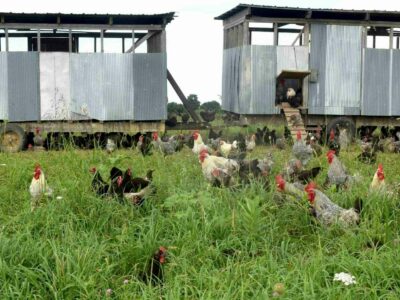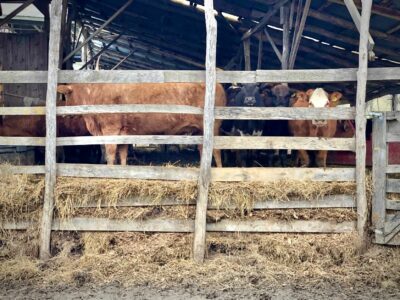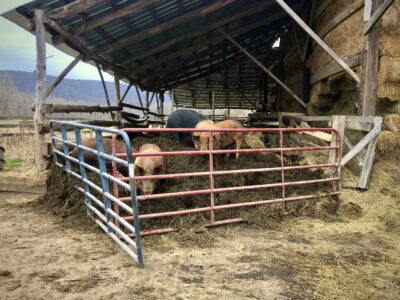



Polyface Farm: a diversified operation building resiliency and stacking enterprises
Farming based on symbiosis through crop and livestock diversificationWith higher prices of fertilizer, grain and petroleum as a result of the Russian-Ukrainian War, issues arise on many farms but not for Polyface Farm. Self-described as a lunatic farmer Joel Salatin explains the significance of diversity in agriculture and what it means for his farm in Virginia and for others looking to diversify.
“We own 950 acres - 700 of that is forest and 250 is open. And we lease another 1,500 acres in the immediate area on about 15 different properties,” Salatin said. “We have beef, pork, chicken - both meat and eggs - ducks, lamb, turkey and rabbit. Everything is either on pasture or has a pasture component using portable infrastructure.”
When comparing his farm to conventional agriculture, Salatin says the biggest differences are that the animals aren’t stationary, and their pasture management reflects nature.
“In America today, most animals are assumed to be at least finished in confinement, but ours are outside and moving,” he said. “For example, we move our cows every day to a new paddock. We'll have 400 on three acres for a day and then they are moved.”
Polyface Farm utilizes a unique symbiotic relationship between birds and herbivores to further improve the fertility and cleanliness of the farm.

“The first thing we did with the layers was to incorporate them with the cows, like the Egret on the rhino’s nose. One of the most symbiotic relationships in nature is a bird following herbivores,” he explained. “So, we developed an egg mobile to follow the cows. The chickens then free range out from the egg mobile, scratch through cow patties, incorporate them into the soil, eat out the fly larva and act as a pest sanitation tool for the cow herd.”
The idea is to have a very high impact for a day and a long rest period until the animals come back to use the portable electric fence paddocks.
“We don't buy any fertilizer, and we don't buy any seeds. We haven't planted a seed in 60 years. We're into perennial prairie polycultures,” he described. “The fertility comes from the manure load and the strategic movement of the animals.”
Furthermore, in the winter, Polyface Farm has a special technique of creating their own fertilizer from livestock waste while the animals are indoors and sheltered from the elements.

“We feed hay under the shed roof’s awning, and we have a commercial chipper that creates woodchips as our carbon base for what we call the ‘carbonaceous diaper’ to absorb the manure and urine that the cows are generating when they're eating hay,” Salatin explained. “Then, we put corn in it, the corn ferments in that anaerobic bedding pack. In the springtime, the cows go out to graze again, and we put in the pigs. The pigs then seek the fermented corn, oxygenate it and convert it from anaerobic to aerobic compost.”

Salatin explains why he manages his farm this way and the benefits it brings:
1) Ecological
“It's the best way to mimic the patterns of nature that built soil. Historically, soil was not built through tillage. It certainly wasn't built with chemical fertilizers, and it certainly wasn't built with corn,” he commented. “Soil was built with perennials and herbivores whether it's the wildebeests on the Serengeti, the bison of the American prairies or the mastodons of Eurasia.”
2) Economic
“When you move towards diversification, the farm equity is not in capital-intensive, depreciable infrastructure. It's actually in management. It's people-centric in management, knowledge and customers,” Salatin commented.
As a diverse enterprise, Polyface Farm is able to direct market rather than selling into a sale barn for the commodity business.
“We're a branded product that sells to our clientele at retail prices. By doing it this way, we have less depreciable infrastructure per annual gross income,” he stated. “The average American farm today takes roughly $4 of depreciable infrastructure to generate $1 in annual gross sales. In other words, a farmer is producing $100,000 in gross income is going to have $400,000 worth of just buildings and machinery. Our ratio is not 4:1, it's $0.50 to $1. We're 800% different.”
Instead, the biggest expense for their farm is labor as there’s about 25 workers earning a living from Polyface Farm.
“That's where the naysayers say ‘I knew it doesn't work. You’ve got to have all these people on a farm.’ Well, what's wrong with people on a farm? What's wrong with people in rural America? What's wrong with rejuvenating our rural businesses?” Salatin argued. “We think it's a good trade off to trade energy intensity, capital intensity, infrastructure intensity and depreciation intensity for human intensity.”
Salatin speaks of recent events in today’s globalized market system, showing that diversifying agriculture and having human labor can create a level of resiliency to large shocks in the economy.
“For the average farmer in America, 50% of their expenses is petroleum. On our farm, it's only 5%. In the last 12 months when Tyson raised their prices 32% on beef, we only had to raise ours 10% because we don't buy Russian fertilizer or Ukrainian wheat, and these huge shocks in the system are starting to affirm some of the economic decisions,” he explained. “We've been accused of being inefficient, but there may be something more powerful than efficiency, and that is resiliency. If you're not first resilient, there's nothing to be efficient about.”
Prior to the Russian-Ukrainian War, the world faced significant supply chain impacts resulting from the COVID-19 pandemic.
“Do you really think that we would have had more resiliency in the food system if instead of having 150 to 300 mega, 5000-person, centralized processing facilities around the country, we had 150,000 to 200,000 neighborhood, 50-employee canneries, abattoirs and processing facilities?” he asked. “I think that having a democratized, diversified and decentralized food portfolio offers more resiliency in the supply chain than just a few mega centralized facilities.”
3) Animal welfare
“I know this is a touchy subject among farmers, and we certainly don't worship our animals, but we do want to provide each one of them a habitat that allows them to fully express its individual distinctiveness. For example, the pigness of the pig, the cowness of the cow,” he described. “In conventional agriculture, the only question we ask is: how can we grow them fatter, faster, bigger and cheaper? When we take that mechanistic view to life, it has ramifications in other things.”
4) Increased nutrient density
“We've subjected our eggs, chicken, beef and pork to numerous empirical nutritional profile testing. The differences are absolutely astounding,” he said. “We did an egg test several years ago. The USDA nutrition label on eggs says that each egg has 48 micrograms of folic acid. Our eggs average 1,038 micrograms of folic acid per egg. We have 300% more riboflavin in beef than in feedlot, grain-fed beef. We're not talking about a 10% variation; it doesn't even look like the same product.”
Why stacking enterprises is important
Salatin continues to explain an important concept of diversified operations: stacking enterprises.
“You're actually stacking additional enterprises on an existing land base. You're farming the vertical space, the cubic space, rather than just the linear space,” he explained. “You're thinking below the soil as well as above the soil.”
For example, Polyface Farm has pastures that run cows, meat chickens, egg chickens, turkeys, sheep and ducks. This doesn’t necessarily mean that the animals are on the same square foot of ground at the same time, rather they are stacked as different enterprises across the land throughout the season.

“What that does is confuse the pathogens, and it gives you a lot more income per acre,” he said.
Furthermore, to expand a farming operation or expand its living income, the traditional option has been to buy a neighbor’s farm when it becomes available. Salatin encourages looking at how to make more from their existing land to maximize its potential.
“Rather than looking outside the boundary fences, we need to realize that as we stack these enterprises, we can generate way more income per acre with what we have instead of thinking we have to absorb the neighbor's place in order to get enough scale to stay in business and include the successional generation,” he emphasized.
Salatin closes with how his farming style came about.
“It’s in my DNA. My paternal grandfather was a charter subscriber to Rodale’s Organic Gardening and Farming Magazine when it came out in 1948. He had this large, organic garden, compost pile, octagonal chicken house, etc.,” he explained. “My dad got that environmental bent from him, and I got it from dad. I grew up this way, and we just always did this. I've simply taken the concepts and just keep refining, adding and trying to do a little better, and I'm having more faith in this every day.”
Salatin offers resources provided by the farm to learn more about Polyface Farm and their methodologies.
“We do offer a lot of education. We have a lot of farm tours; we do seminars, and I've written 15 books. I'm doing a video curriculum: Farm Like a Lunatic. I do a blog: The Musings of the Lunatic Farmer, and we do gatherings here. I would just encourage anyone who's interested to jump on the website polyfacefarms.com and check us out,” he concluded.







